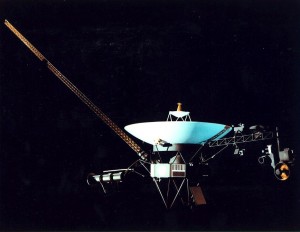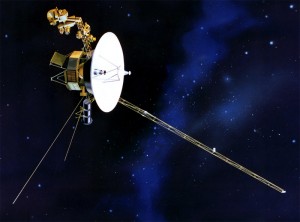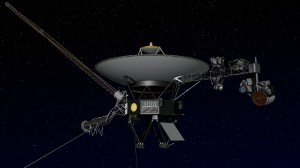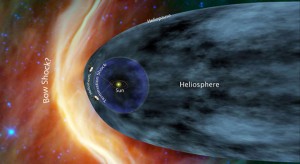The Voyager Program was a five-year mission by NASA to explore planets Jupiter and Saturn. It was composed of twin spacecrafts Voyager 1 and Voyager 2. Although both spacecrafts already completed their original missions, they are still operating and exploring the deep space.

In this article, we will explore the two spacecrafts from the flight path they followed to the discoveries they made and where the two spacecrafts are today.
The Voyager Spacecrafts
Because the voyagers were to travel into deep space where the level of radiation is high, the spacecrafts had their components designed to withstand these harsh conditions and the sensitive instruments were hardened.
The voyagers can carry out 10 scientific experiments and are equipped with television cameras, infrared and ultraviolet sensors, magnetometers, plasma detectors, and cosmic ray and charged particle sensors. They also have attached radios that capture and transmit information about the planets’ atmosphere and ring systems.
The twin spacecrafts were built at the Jet Propulsion Laboratory in Southern California. NASA provided all the funding for the project.
The Voyagers beam data to Earth and receive commands through the Deep Space Network, a global spacecraft tracking system.
What Powers The Voyager Spacecrafts?
Since the voyager spacecrafts were destined to travel very far from the sun, it was not possible to use solar panels as a source of power, as is the case with other space exploration missions.
NASA chose a strategic time for launching the two spacecrafts. The two voyagers were designed to take advantage of a special alignment of the outer planets that occurs once every 176 years.
With this alignment, the spacecrafts were able to navigate from one planet to the other easily, as the gravity of one planet propelled the spacecrafts to the next planet.
Astronomers also equipped the spacecrafts with a series of thrusters so it could be able to make delicate maneuvers to propel and direct it to its destination.
The scientific instruments onboard the spacecrafts are powered by electricity that is generated onboard by a mechanism similar to a mini nuclear generator. Radioisotope thermoelectric generators turn the heat generated by the breakdown of plutonium dioxide into electricity.
The Golden Record- The Voyagers Bear a Message to Aliens
NASA’s scientists were positive that the Voyagers would leave the solar system eventually and venture into deep space.
Just in case they came across extra terrestrial civilizations (aliens), these two spacecrafts bear a golden record that is a time capsule and interstellar message directed to any aliens, civilizations or future humans who may recover any of the spacecrafts.
This record is composed of different sounds and pictures. There is music, natural Earth sounds including whale calls, storms, and volcanoes, manmade sounds including those of airplanes, rocket launches and greetings in 55 languages.
The record has pictorial instructions explaining how to play the sounds and details indicating the location of Earth so that any recipient will know where the message came from.
The Voyager Missions
Voyager 1 and 2 are regarded as twin spacecrafts because they are identical. However, this is as far as their similarity goes. Each spacecraft had its launch date, flight path and mission. This is why we are going to explore the two missions separately.
Voyager 1 Mission
Voyager 1 is Earth’s farthest spacecraft and the first manmade object to travel to and explore interstellar space. It was designed to fly by two of the gas giants, Jupiter and Saturn.

Voyager 1 Launch
Voyager 1 launched on September 5 1977 from Cape Canaveral, two weeks after the launch of Voyager 2. Its rocket came close to running out of fuel during the launch but it launched safely. It overtook Voyager 2 and became the first to arrive and fly by Jupiter and Saturn.
Voyager 1 Flight Path
Voyager 1’s mission was to fly past Jupiter and Saturn, which it did. It came closest to Jupiter on March 5 1979 when the spacecraft was just 174,000 miles away from Jupiter’s turbulent cloud tops. It then continued its journey to Saturn to explore the planet’s rings and natural satellites.
Voyager 2 Mission
Voyager 2 is NASA’s longest operating mission. Just like Voyager 1, Voyager 2 was designed to explore Saturn and Jupiter. However, Voyager 2 was also set to fly by and explore Uranus and Neptune if it was still in operating condition after studying Jupiter and Saturn.
When NASA designed Voyager 2, it was meant to act as a backup. If Voyager 1 had failed to complete its mission, Voyager 2 would have followed Voyager 1’s trajectory and abandoned its mission to explore Uranus and Neptune. This explains the launch of two identical spacecrafts one after the other.

Voyager 2 Launch
Voyager 2 was launched on August 20, 1977 from Cape Canaveral. While it launched first, it was the second to fly by the two gas giant planets. It reached Jupiter in 1979, two years after its launch.
Voyager 2 Flight Path
Voyager 2 flew past Jupiter, Saturn, Uranus and Neptune becoming the first spacecraft to visit Uranus and Neptune. It beamed back the first images of Jupiter in April 1978 when it was 165 million miles away.
In 1980, it beamed back the first images of Saturn, the ringed planet. Its closest approach to Saturn was on August 26 1981. It captured hundreds of images of the planet, its satellites and rings.
It came closest to Uranus on January 24 1986 and made the closest approach to Neptune on Aug 25 1989.
Discoveries Made By Voyager 1 & 2
Voyager 1 & 2 spacecrafts are the longest operating spacecrafts in deep space. Over the years, the two spacecrafts have made amazing discoveries and captured spectacular images of the outermost planets showing details that had not been seen before. The twin spacecrafts studied all the outer giant planets, 48 of their natural satellites, their rings and magnetic fields. Since both spacecrafts followed different flight paths, we will explore the discoveries made by each spacecraft separately.
Voyager 1 Discoveries
Voyager 1 passed by Jupiter and Saturn capturing breathtaking images of the largest planet and the ringed planet. It beamed these images back to Earth where they are used for educational and other purposes. Here are its discoveries about the outermost planets.
In March 1979, Voyager 1 spotted a thin ring orbiting Jupiter and discovered two previously unseen moons of Jupiter, Thebe and Metis.
It also captured high-resolution images of the Galilean moons Io, Europa, Ganymede, Callisto and Amalthea.
It found that Io has volcanoes and a molted yellow-brown-orange surface, which indicates that it could have an active interior.
Voyager 1 also took ephemeral images of Europa revealing that it has a smooth surface broken up by lines, which is a sign of ice. This also indicates that there is a possibility that an ocean exists beneath its surface.
Saturn turned out to be a planet full of mysteries. Voyager 1 was focused on studying the F ring of Saturn, which was first seen by Pioneer 11. Its high-resolution camera discovered two new moons Prometheus and Pandora, whose orbits cause the debris in the F ring to stay in a defined orbit.
In its exploration of Saturn, it also discovered Atlas and a new ring that came to be known as the G ring and beamed back images of Saturn’s other moons.
Voyager 2 Discoveries
Since Voyager 1 had completed its main mission without fail, Voyager 2 was free to go ahead in its planned mission to explore Uranus, Neptune and afterwards venture beyond the solar system. It made history by capturing the first close-up images of Uranus and Neptune. Here are its findings about the four planets it visited.
The images of Jupiter that Voyager 2 beamed back to Earth were compared to those captured earlier by its twin spacecraft, Voyager 1. Scientists noticed changes in the great red spot when they compared the images.
Voyager 2 also captured the surfaces of some of Jupiter’s moons revealing more details and confirming Voyager 1’s findings that Jupiter’s moons are active worlds of their own.
One of the breathtaking images it took were images of the icy Europa showing its cracks in more details. It discovered Adrastea, a tiny moon of Jupiter that is about 19 miles in diameter.
Wanting to confirm their suspicion that Saturn was circled by many rings, scientists had set up an experiment to watch the star Delta Scorpii in its two and a half hours passage through the planes of Saturn’s rings. The cameras aboard the Voyager observed as the star’s dim light revealed the small ringlets of Saturn, confirming what scientists had speculated.
When Voyager 2 flew by Uranus, it found out that this planet has a surprisingly strong magnetic field that was oddly 55 degrees off the planet’s axis. This orientation left scientists puzzled.
It spotted 10 moons of Uranus that had not been seen before from Earth. It also saw signs of geological activity including canyons on Miranda, one of Uranus largest moons.
Voyager 2 also discovered that Uranus has nine rings that are made up of larger and younger particles that those of Jupiter and Saturn.
Close observations of Uranus revealed that its South Pole was facing the sun and there was a layer of haze over its sunlit pole.
Uranus’s atmosphere was found to be made up of 85% hydrogen and 15% Helium.
Voyager 2 also took pictures of one of Uranus’s moons Miranda. These images show that the moon’s surface is unique and appears to have been pushed together and broken apart several times. Scientists suspect that it could be the strongest moon in the solar system.
Neptune was found to be a dynamic planet with several dark spots and extremely fast winds blowing below its atmosphere.
Voyager 2 discovered six new moons. It is also a ringed planet with three complete rings around it.
Neptune’s largest moon, Triton, had large eruptions similar to geysers emitting nitrogen gas and dust particles into the atmosphere.
Voyager Interstellar Mission
Voyager 1 and 2 completed their primary missions successfully. Now, both are on a new mission, which started when the two spacecrafts had been in flight for more than 12 years.
The new mission is the Voyager Interstellar Mission (VIM). Its purpose is to explore the outer solar system, search for the heliopause boundary and move on beyond the solar system.

Current Positions of the Voyagers
In 1998, Voyager 1 passed Pioneer 10 becoming the furthest manmade object in space. Voyager 2 also moved into interstellar space after its flyby of Neptune.
Both spacecrafts are now in the Heliosheath, the farthest layer of the Heliosphere where the solar wind is slowed down by the pressure of interstellar gas this region.
NASA has maintained contact with the two probes to keep track of conditions in the outer expanses of the solar system. As the spacecrafts move farther from Earth, NASA’s messages are taking longer and longer to reach them.
Will Voyager 1 and 2 Ever Return?
The two voyagers are not meant to return to Earth. The have a long scientific life remaining. Their power is expected to last through the year 2020-2025, during which the instruments will continue operating and the spacecrafts will continue exploring interstellar space. They will then wander the Milky Way.
